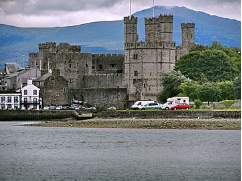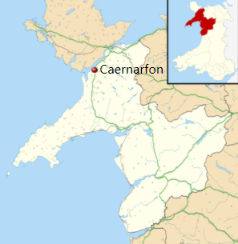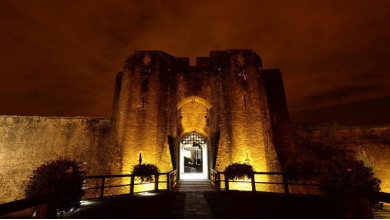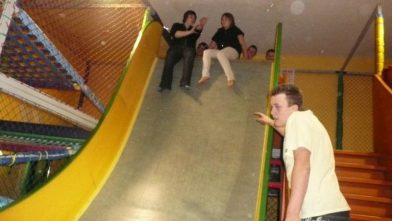Caernarfon, Gwynedd, Wales, UK 作者: 来源: 发布时间:2021-09-17
I. Population and Area
Continent: Europe
Country: The U.K
State/Province: Wales
City/Town: Caernarfon, Gwynedd
Total Area: 984 (sq mi) (Gwynedd)
Population in 2011: (thousand)

II. Natural Geography (environment and resources)
Geography
Caernarfon is situated on the southern bank of the Menai Strait facing the Isle of Anglesey. It is situated 8.6 miles (13.8 km) south-west of Bangor, 19.4 miles (31.2 km) north of Porthmadog and approximately 8.0 miles (12.9 km) west of Llanberis and Snowdonia National Park. The mouth of the River Seiont is in the town, creating a natural harbour where it flows into the Menai Strait. Caernarfon Castle stands at the mouth of the river. The A487 passes directly through Caernarfon, with Bangor to the north and Porthmadog to the south.
As the crow flies, the summit of Snowdon lies a little over 9.6 miles (15.4 km) to the southeast of the town centre.

Sea
Caernarfon was at one time an important port, exporting slate from the Dyffryn Nantlle quarries. This traffic was facilitated from 1828 by the Nantlle Railway which predated far more widely known ventures such as the Liverpool and Manchester Railway and the Ffestiniog Railway.
Rail
Five passenger stations have served the town: Caernarvon railway station opened in 1852 as the western terminus of the Bangor and Carnarvon Railway. This connected the town with the North Wales coast and the expanding national network. Carnarvon Castle railway station opened in 1856 as the northern passenger terminus of the 3ft 6in narrow gauge Nantlle Railway. This service ended in 1865 when the line being built from the south by the standard gauge Carnarvonshire Railway took over most of its trackbed. The Carnarvonshire Railway's temporary northern terminus was at Pant to the south of the town. Pant station opened in 1867. At the same time the Carnarvon and Llanberis Railway built its line from Llanberis to Caernarfon. Its temporary western terminus was called Carnarvon (Morfa). It opened in 1869 near the modern road bridges over the Afon Seiont. For a short period, therefore, Caernarfon had three terminating stations on its edges. Records are contradictory, but this ended in either 1870 or 1871 when they were connected by a line through the town using the tunnel which survives, having been converted in 1995 for road traffic. When the through route was opened Pant and Morfa stations closed and the original station became the town's only station. The London and North Western Railway also took over all the lines mentioned leaving one station and one service provider by 1871.
The services to Llanberis and south to Afon Wen closed progressively from the 1930s, with tracks being lifted in the mid-1960s, but Caernarvon station survived until 1970, becoming one of the last passenger services to be closed under the Beeching Axe; it is now the site of a Morrisons supermarket. The fifth station was opened in 1997 <'The Snowdon Ranger', 1997 ref> on the old trackbed in St. Helen's Road. It is the northern terminus of the 2ft narrow gauge Rheilffordd Eryri / Welsh Highland Railway. Work began on a permanent station for the town in February 2017. The new station opened to passengers in Spring 2019. Heritage steam services provide links to Porthmadog, where passengers can change for services on the Ffestiniog Railway to Blaenau Ffestiniog.
Bus
Bus services in the town are provided by Arriva Buses Wales, and a number of smaller, local operators. Longer distance, cross country services are operated by Lloyds Coaches, and connect the town with Bangor to the north, and Aberystwyth via Porthmadog, Dolgellau and Machynlleth to the south. These services are part of the Welsh Government funded TrawsCymru network.
Road
The A487 trunk road bisects the town, providing access to major urban areas along the North Wales coast and the Port of Holyhead, via the A55 expressway. Llanberis at the foot of Snowdon can be reached via the A4086, which heads east out of the town towards Capel Curig.
Bike
Heading north out of the town is the Lôn Las Menai cycle path to nearby Y Felinheli. Heading south out of the town is the Lôn Eifion cycle path, which leads to Bryncir, near Criccieth. The route provides views into the Snowdonia mountains, down along the Llŷn Peninsula and across to the Isle of Anglesey.
Air
Caernarfon Airport is 4.5 miles (7.2 km) to the south west, and offers pleasure flights and an aviation museum.
Foot
The Aber Swing Bridge is a pedestrian swing bridge that crosses over the Afon Seiont to connect pedestrians from the foreshore to the Watergate entrance in the centre of Caernarfon by the Caernarfon Castle.
III. Economy
Caernarfon's historical prominence and landmarks have made it a major tourist centre. As a result, many of the local businesses cater for the tourist trade. Caernarfon has numerous guest houses, inns and pubs, hotels, restaurants and shops. The majority of shops in the town are located either in the centre of town around Pool Street and Castle Square (Y Maes), or on Doc Fictoria (Victoria Dock). A number of shops are also located within the Town Walls.
The majority of the retail and residential section of Doc Fictoria was opened in 2008. The retail and residential section of Doc Fictoria is built directly beside a Blue Flag beach marina. It contains numerous homes, bars and bistros, cafés and restaurants, an award-winning arts centre, a maritime museum and a range of shops and stores.
Pool Street and Castle Square contain a number of large, national retail shops and smaller independent stores. Pool Street is pedestrianised and serves as the town's main shopping street. Castle Square, commonly referred to as the 'Maes' by both Welsh and English speakers, is the market square of the town. A market is held every Saturday throughout the year and also on Mondays in the summer. The square was revamped at a cost of £2.4 million in 2009. However, since its revamp the square has caused controversy due to traffic and parking difficulties. During the revamp, it was decided to remove barriers between traffic and pedestrians creating a 'shared space', to try and force road users to be more considerate of pedestrians and other vehicles. This is the first use of this kind of arrangement in Wales, but it has been described by councillor Bob Anderson as being 'too ambiguous' for road users. Another controversy caused by the revamp of the Maes was that a historic old oak tree was taken down from outside the HSBC bank. When the Maes was re-opened in July 2009 by the local politician and Heritage Minister of Wales, Alun Ffred Jones AM, he said, "the use of beautiful local slate is very prominent in the new Maes."
There are many old public houses serving the town, including The Four Alls (that has recently had a £500,000 renovation), The Anglesey Arms Hotel, The Castle Hotel, The Crown, Morgan Lloyd, Pen Deitch and The Twthill Vaults. The oldest public house in Caernarfon is the Black Boy Inn, which remained in the same family for over 40 years until sold in 2003 to a local independent family business. The pub has stood inside Caernarfon's Town Walls since the 16th century, and many people claim to have seen ghosts within the building.
In and around the Town Walls are numerous restaurants, public houses and inns, and guest houses and hostels.
Median Household Income
19454 | Horsham | Lower Gwynedd | Montgomery | North Wales | Upper Gwynedd | Montgomery County |
$95,128 | $97,663 | $102,725 | $110,043 | $94,679 | $95,784 | $91,546 |
Average Household Income
19454 | Horsham | Lower Gwynedd | Montgomery | North Wales | Upper Gwynedd | Montgomery County |
$132,256 | $131,363 | $182,908 | $144,987 | $105,858 | $129,539 | $125,928 |
Per-Capita Income
19454 | Horsham | Lower Gwynedd | Montgomery | North Wales | Upper Gwynedd | Montgomery County |
$52,534 | $49,580 | $71,896 | $55,298 | $42,242 | $52,746 | $48,845 |
High Income Households
19454 | Horsham | Lower Gwynedd | Montgomery | North Wales | Upper Gwynedd | Montgomery County |
18.5% | 17.6% | 29.9% | 22.6% | 8.9% | 16.0% | 15.4% |
Reference Website:
https://www.payscale.com/research/UK/Location=Norwich-England%3A-Norfolk/Salary
https://www.incomebyzipcode.com/pennsylvania/19454
IV. Industrial Characterisitics
Major industries:
The county has a mixed economy. An important part of the economy is based on tourism: many visitors are attracted by the many beaches and the mountains. A significant part of the county lies within the Snowdonia National Park, which extends from the north coast down to the district of Merioneth in the south; it is much larger than Snowdonia proper. But tourism provides seasonal employment and thus there is a shortage of jobs in the winter.
Agriculture is less important than in the past, especially in terms of the number of people who earn their living on the land, but it remains an important element of the economy. The most important of the traditional industries is the slate industry, but these days only a small percentage of workers earn their living in the slate quarries.
Industries which have developed more recently include TV and sound studios: the record company Sain has its HQ in the county. There is also one nuclear power station in Gwynedd at Trawsfynydd The education sector is also very important for the local economy, including Bangor University and Menai College.
Major projects and related introductions:
Caernarfon multi-million-pound regeneration projects
With £15 million of funding being invested into the Caernarfon waterfront, 2 of the 3 major regeneration projects have opened recently. The waterfront area of Caernarfon has seen a transformation in the last few months, where work has started on the old Cei Llechi site, which has been identified as a key redevelopment area by Gwynedd Council. Through the Caernarfon Waterfront Initiative, the Council is project managing the £15m project on behalf of Visit Wales. This initiative has seen Gwynedd Council assisting a number of key local partners to deliver Galeri 2, the new Welsh Highland Railway station and the Cei Llechi - Island Site with the aim of making a major contribution to Caernarfon’s regeneration along with the wider local economy.
Councillor Ioan Thomas, Gwynedd Council Cabinet Member for Economic Development said;“The Council and its partners have completed 2 of the main Caernarfon Waterfront Initiative projects, Galeri 2 and Welsh Highland Railway. The Cei Llechi, Island Site, project is underway and Grosvenor Construction of Kinmel Bay have been working on the project since October. Through a number of initiative projects we’re certain that this historical area of Caernarfon can look forward to a bright future.
"The Waterfront is steeped in a rich history and we’re committed to securing a thriving and sustainable future for the area. Two of the new assets have opened and it’s a pleasure to be told how successful the initial period has been, with local people and visitors enjoying these exceptional facilities. "Through working with our partners, we’re trying to maximise the town’s heritage and cultural assets to ensure that Caernarfon is a vibrant destination for local people and visitors alike”.
Reference Website:
https://www.visitsnowdonia.info/caernarfon-multi-million-pound-regeneration-projects
V. Attractions
1. Caernarfon Castle:

A brute of a fortress. Caernarfon Castle's pumped-up appearance is unashamedly muscle-bound and intimidating. Picking a fight with this massive structure would have been a daunting prospect. By throwing his weight around in stone, King Edward I created what is surely one of the most impressive of Welsh Castles. Worthy of World Heritage status no less!
Most castles are happy with round towers, not Caernarfon! Polygonal towers were the order of the day, with the Eagle Tower being the most impressive of these. You will also note the colour coded stones carefully arranged in bands.
2. The Fun Centre:

Gog The Dragon must be lucky, he's got over 14,000 sq ft of play space, but he's willing to share it with your little beasties too!
Whether they'll want to share it all they can't say, given that there is a 25ft drop slide to contend with! But that's ok, because there's a double 25ft drop slide too, meaning you can do it with them. Isn't that nice?!
Aside from the frankly mental slide situation, all the usual adventure play excitement is here from ball pools and mini maze to swing balls and scramble nets, loads to entertain and exhaust even the hardiest kid. There is of course an under 4s' zone too, which features soft construction blocks, small slide and loads of bits and bobs for them to scramble around and climb on!
On the top floor, there's Gog's Driving School where there's a fleet of varying vehicles ready for you to take a spin round the racetrack.
Plus, there's a Laser Space Sport arena, where you can get some zero contact warfare action and zap at stuff with infra red equipment. Cool!
And when they're tired enough to take some education, the mini museum on site here offers some interesting and interactive displays on local history. Bonus!
Reference Website:
https://www.dayoutwiththekids.co.uk/things-to-do/north-wales/gwynedd/caernarfon
VI. History
The present city of Caernarfon grew up around and owes its name to its Norman and late Medieval fortifications. The earlier British and Romano-British settlement at Segontium was named for the nearby Afon Seiont. After the end of Roman rule in Britain around 410, the settlement continued to be known as Cair Segeint ("Fort Seiont") and as Cair Custoient ("Fort Constantius or Constantine"), of the History of the Britons, cited by James Ussher in Newman's life of Germanus of Auxerre, both of whose names appear among the 28 civitates of sub-Roman Britain in the Historia Brittonum traditionally ascribed to Nennius. The work states that the inscribed tomb of "Constantius the Emperor" (presumably Constantius Chlorus, father of Constantine the Great) was still present in the 9th century. (Constantius actually died at York; Ford credited the monument to a different Constantine, the supposed son of Saint Elen and Magnus Maximus, who was said to have ruled northern Wales before being removed by the Irish.) The medieval romance about Maximus and Elen, Macsen's Dream, calls her home Caer Aber Sein ("Fort Seiontmouth" or "the caer at the mouth of the Seiont") and other pre-conquest poets such as Hywel ab Owain Gwynedd also used the name Caer Gystennin.
The Norman motte was erected apart from the existing settlement and came to be known as y gaer yn Arfon, "the fortress in Arfon". (The region of Arfon itself derived its name from its position opposite Anglesey, known as Môn in Welsh.) A 1221 charter by Llywelyn the Great to the canons of Penmon priory on Anglesey mentions Kaerinarfon; the Brut mentions both Kaerenarvon and Caerenarvon. In 1283, King Edward I completed his conquest of Wales which he secured by a chain of castles and walled towns. The construction of a new stone Caernarfon Castle seems to have started as soon as the campaign had finished. Edward's architect, James of St. George, may well have modelled the castle on the walls of Constantinople, possibly being aware of the town's legendary associations. Edward's fourth son, Edward of Caernarfon, later Edward II of England, was born at the castle in April 1284 and made Prince of Wales in 1301. A story recorded in the 16th century suggests that the new prince was offered to the native Welsh on the premise "that [he] was borne in Wales and could speake never a word of English", however there is no contemporary evidence to support this.
Caernarfon was constituted a borough in 1284 by charter of Edward I. The charter, which was confirmed on a number of occasions, appointed the mayor of the borough Constable of the Castle ex officio. The former municipal borough was designated a royal borough in 1963.[The borough was abolished by the Local Government Act 1972 in 1974, and the status of "royal town" was granted to the community which succeeded it. Caernarfon was the county town of the historic county of Caernarfonshire.
In 1911, David Lloyd George, then Member of Parliament for Caernarfon boroughs, which included various towns from Llŷn to Conwy, agreed to the British Royal Family's idea of holding the investiture of the Prince of Wales at Caernarfon Castle. The ceremony took place on 13 July, with the royal family visiting Wales, and the future Edward VIII was duly invested.
In 1955 Caernarfon was in the running for the title of Capital of Wales on historical grounds but the town's campaign was heavily defeated in a ballot of Welsh local authorities, with 11 votes compared to Cardiff's 136. Cardiff therefore became the Welsh capital.
In July 2019 Caernarfon hosted a rally for Welsh independence. The event, organised by AUOB (All Under One Banner) Cymru, included a march through the town centre. Organisers estimated that roughly 8,000 people joined on the march on the town square; local authorities confirmed at least 5,000 attendees. The event featured a number of speakers including Hardeep Singh Kohli, Evra Rose, Dafydd Iwan, Lleuwen Steffan, Siôn Jobbins, Beth Angell, Gwion Hallam, Meleri Davies and Elfed Wyn Jones. Talks covered criticism of Brexit and Westminster with advocating Welsh Independence.
The history of Caernarfon, as an example where the rise and fall of different civilizations can be seen from one hilltop, is discussed in John Michael Greer's book The Long Descent. He writes of Caernarfon:
Spread out below us in an unexpected glory of sunlight was the whole recorded history of that little corner of the world. The ground beneath us still rippled with earthworks from the Celtic hill fort that guarded the Menai Strait more than two and a half millennia ago. The Roman fort that replaced it was now the dim brown mark of an old archeological site on low hills off to the left. Edward I’s great gray castle rose up in the middle foreground, and the high contrails of RAF jets on a training exercise out over the Irish Sea showed that the town’s current overlords still maintained the old watch. Houses and shops from more than half a dozen centuries spread eastward as they rose through the waters of time, from the cramped medieval buildings of the old castle town straight ahead to the gaudy sign and sprawling parking lot of the supermarket back behind us.
VII. Culture
Caernarfon hosted the National Eisteddfod in 1862, 1894, 1906, 1921, 1935, 1959 and 1979. Unofficial National Eisteddfod events were also held there in 1877 and 1880. Caernarfon also hosted the 30th annual Celtic Media Festival in March 2009. Cultural destinations include Galeri and Oriel Pendeitsh.
Galeri is a creative enterprise centre that houses a gallery, a concert hall, cinema, a number of companies, and a range of other creative and cultural spaces. Oriel Pendeitsh is a ground-floor exhibition space adjoining the Tourist Information Centre opposite Caernarfon Castle. The gallery has a varied and changing programme of exhibitions throughout the year.
The Caernarfon Food Festival takes place in the town's streets including The Slate Quay (Cei Llechi) and Castle Square (the Maes), which is pedestrianised for the event (. Stalls are also located along the promenade next to the Menai Strait towards the marina and Doc Fictoria.
The festival was formed in 2015 as a result of public consultation within the town. The first festival was held in 2016. It is organised by Caernarfon Food Festival Group which is made up of local volunteers who hold regular meetings to plan each festival. The festival has a number of supporting groups, including a content group, sponsorship group, technical group, communication group and volunteer group. These groups feed into the main group's monthly meetings. The festival logo was inspired by contributions from pupils at Ysgol Syr Hugh Owen, and designed by Iestyn Lloyd of Cwmni Da. The festival has been supported by Welsh Government through the Food Festival Grant Scheme and was highly commended by Food Awards Wales in 2019. Car parking is provided at the Slate Quay (Cei Llechi) and at other car parks around the town while the Welsh Highland Railway provides transport from Porthmadog. Cycle access is by the cycle tracks along the disused railway lines which include Lôn Las Eifion, which runs from Porthmadog, by-passing Penygroes, and on to Caernarfon, Lôn Las Menai from Felinheli to Caernarfon and Lôn Las Peris from Llanberis to Caernarfon.
VIII. Other information
Sport
Caernarfon Town Football Club (Welsh: Clwb Pêl Droed Tref Caernarfon) is a Welsh football club based in the town, which currently plays in the Cymru Premier, the top level for football in Wales. The club is nicknamed "the Canaries" because of its yellow and green strip. Caernarfon Town plays at The Oval which has a capacity of 3000 people and 250 seated people.
Education
There are four primary schools in Caernarfon, Ysgol yr Hendre being the largest. The others are Ysgol y Gelli, Ysgol Santes Helen and Ysgol Maesincla. The single secondary school serving Caernarfon and the surrounding areas – Ysgol Syr Hugh Owen – currently has between 900 and 1000 pupils from ages 11 to 18. Ysgol Pendalar is a school for children with special needs. Coleg Menai is a further education college for adult learners.
Landmarks
The old County Hall, which went on to become a courthouse, is situated inside the castle walls, next door to the Anglesey Arms Hotel. The old courthouse is built in the Neo-classical style. The courthouse was replaced in 2009 by a new complex designed by HOK on the former Segontium School site in Llanberis Road. The old courthouse adjoins what used to be Caernarfon Gaol, which has been closed since the early 20th century and was subsequently converted into council offices.
There is a small hospital in the town, 'Ysbyty Eryri' (i.e. "Snowdonia Hospital"). The nearest large regional hospital is Ysbyty Gwynedd, in Bangor. Previously, Caernarfon had been chosen as the location of a new prison. HMP Caernarfon would have held up to 800 adult males when constructed, and would have taken prisoners from all over the North Wales area. However, in September 2009 the UK Government withdrew plans to construct the prison. Caernarfon Barracks were commissioned by John Lloyd, County Surveyor of Caernarfonshire, as a military headquarters and completed in 1855.
IX. Contact information
Mayor/Officer: Sion Evans
Tel: 01286 672943
Mail: townclerk@caernarfontowncouncil.gov.wales
Reference Website:
http://www.cyngortrefcaernarfon.llyw.cymru/english/councillors.html
